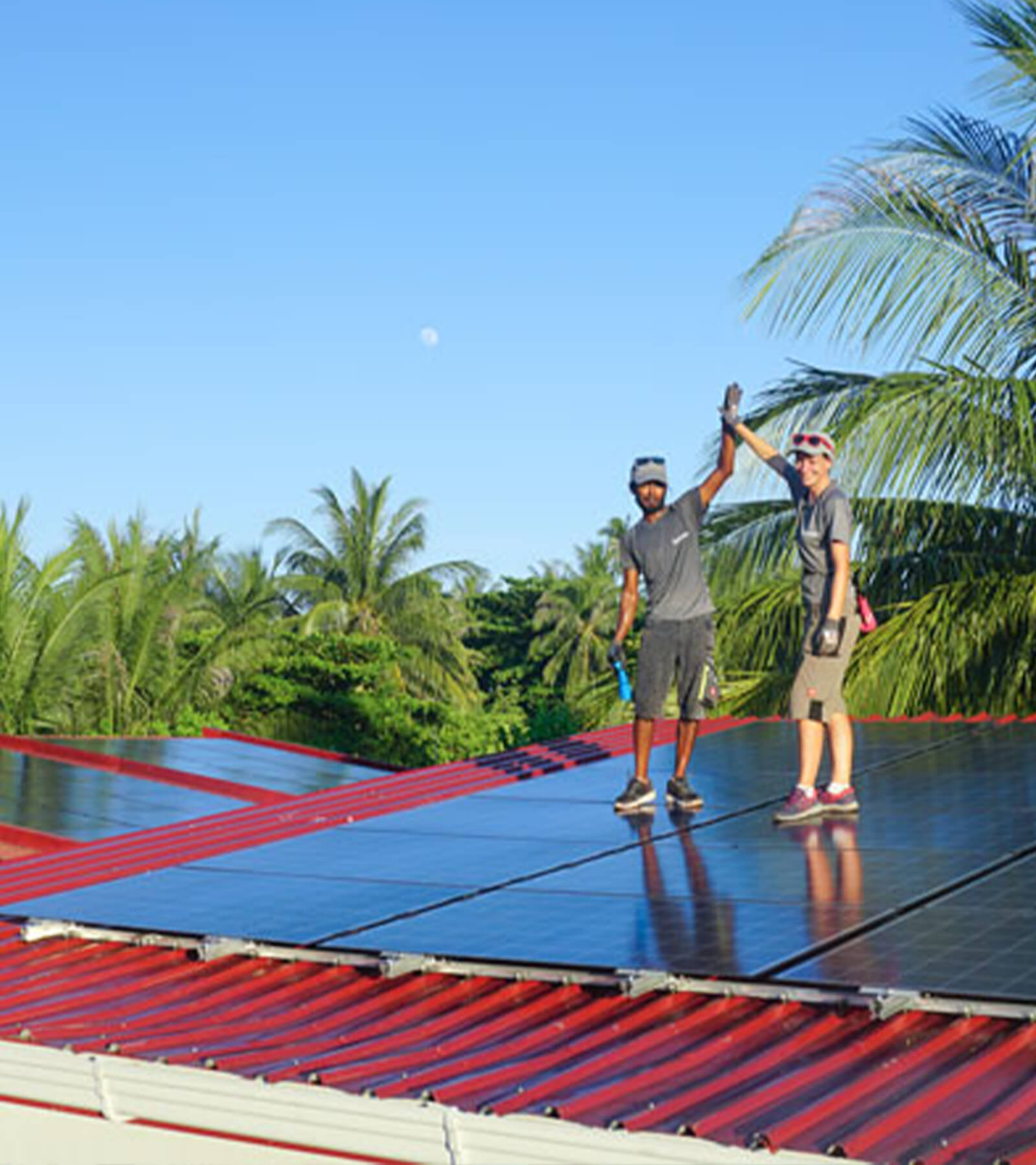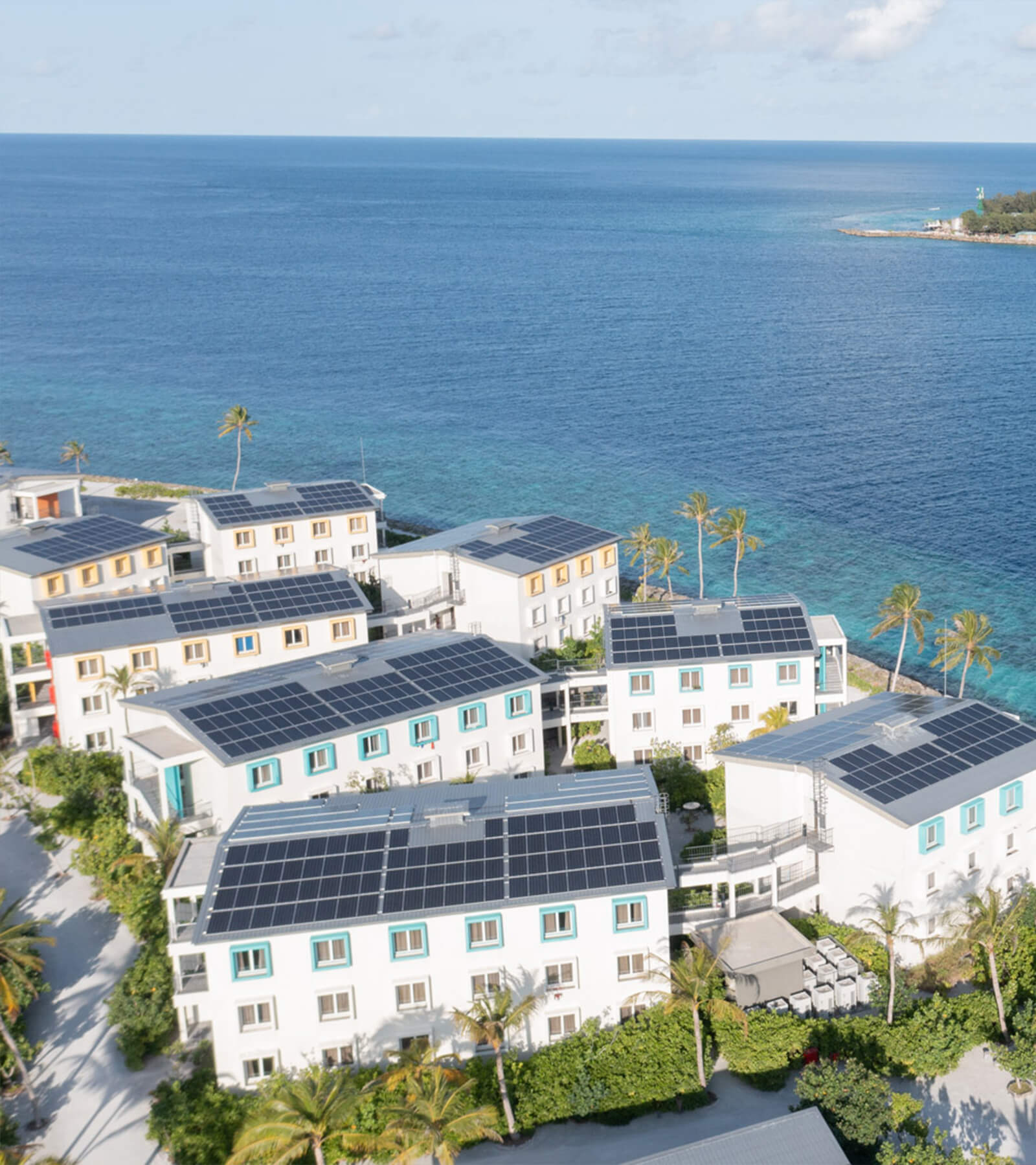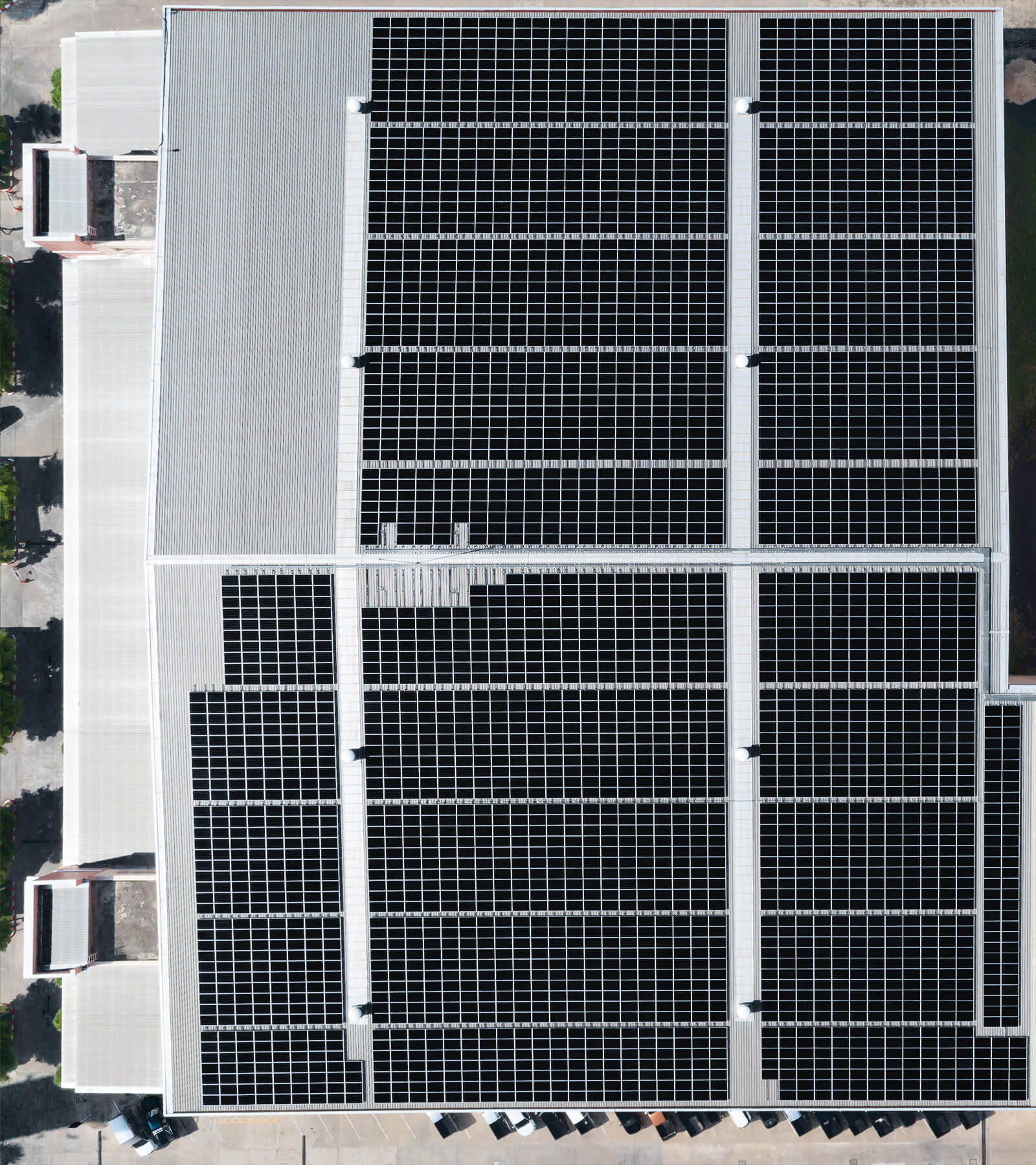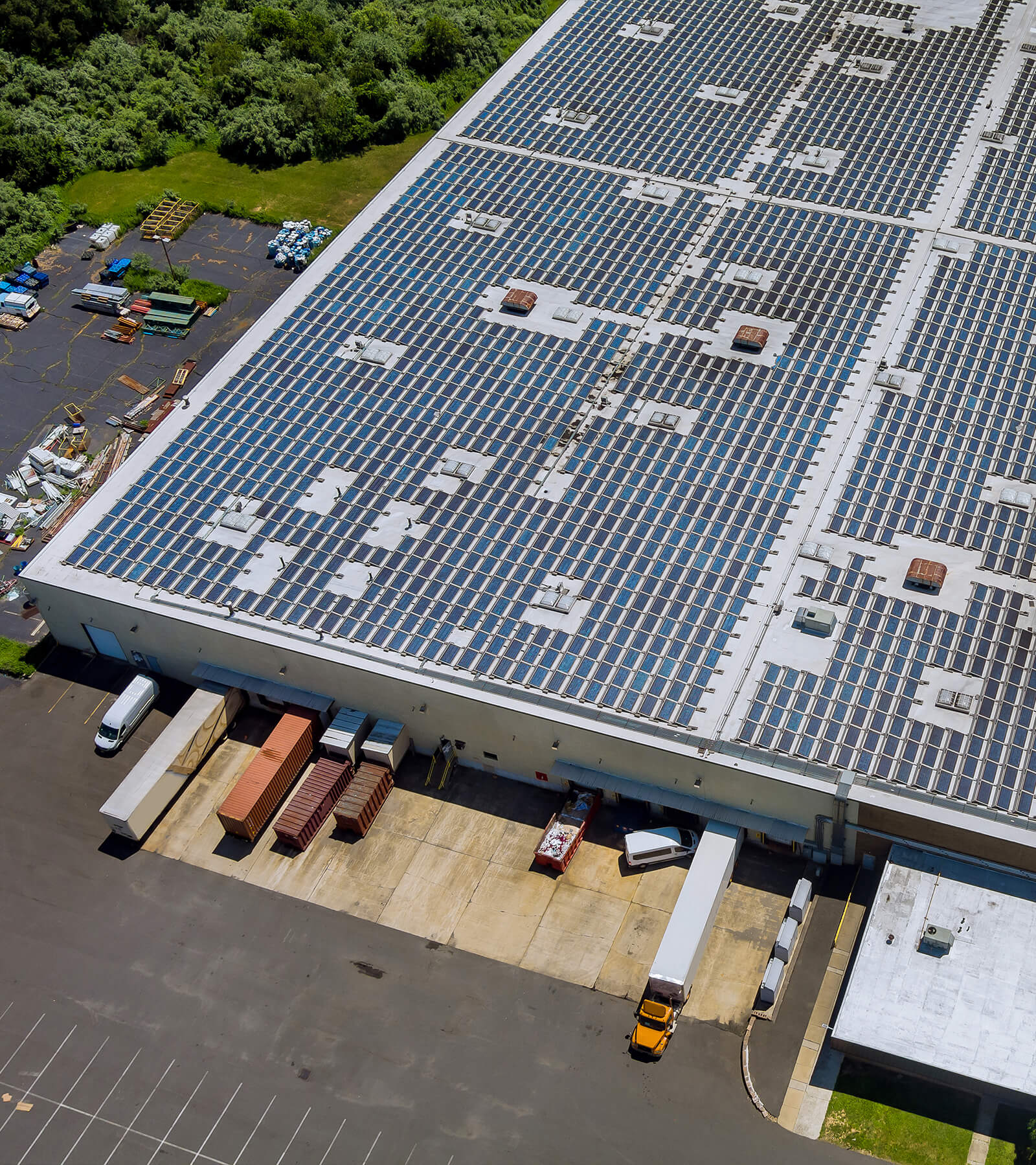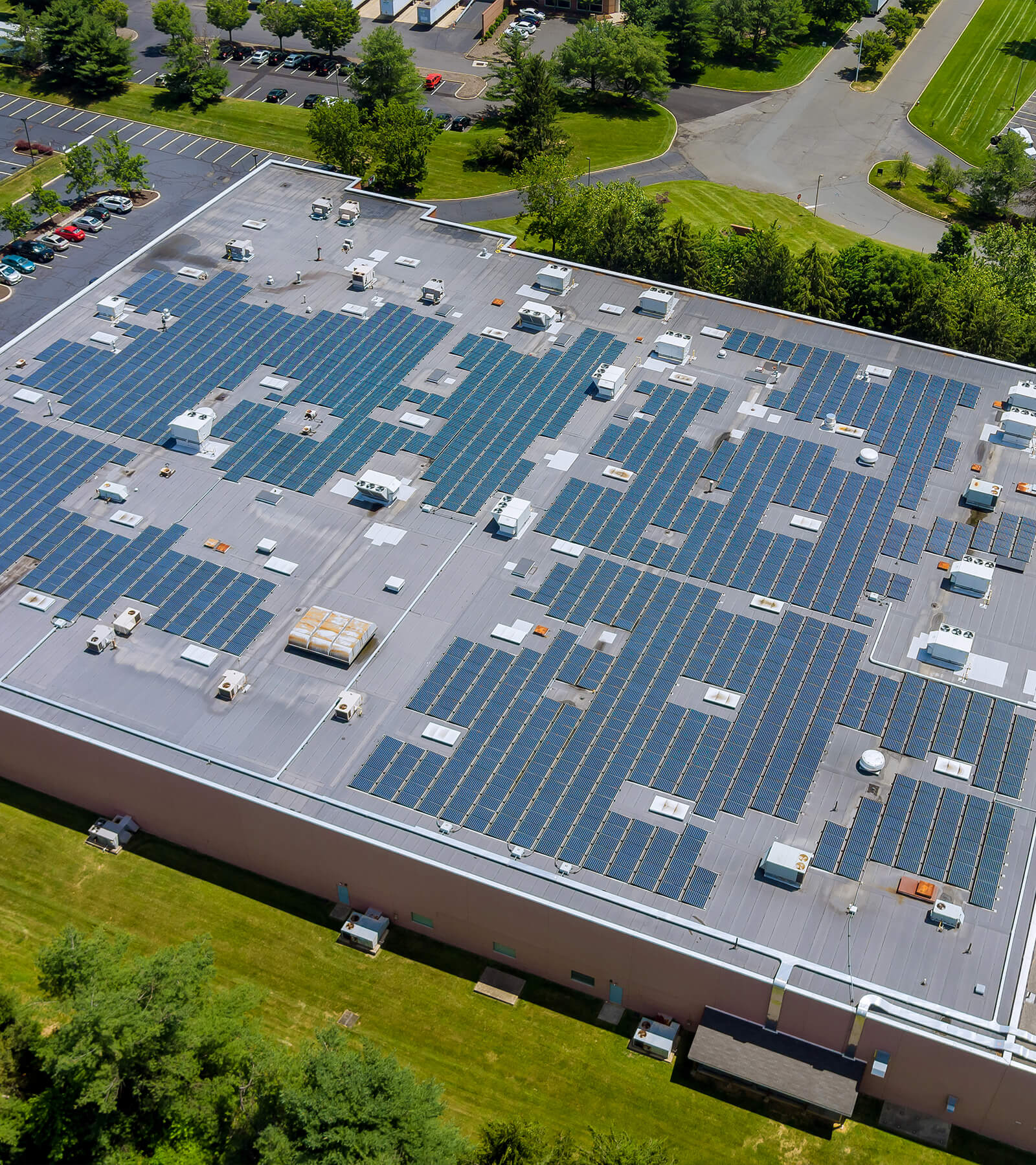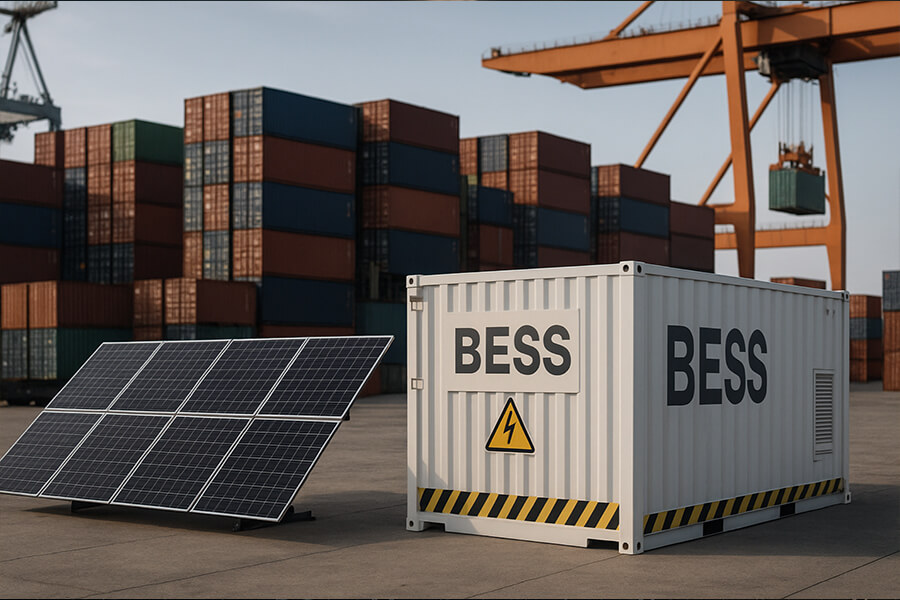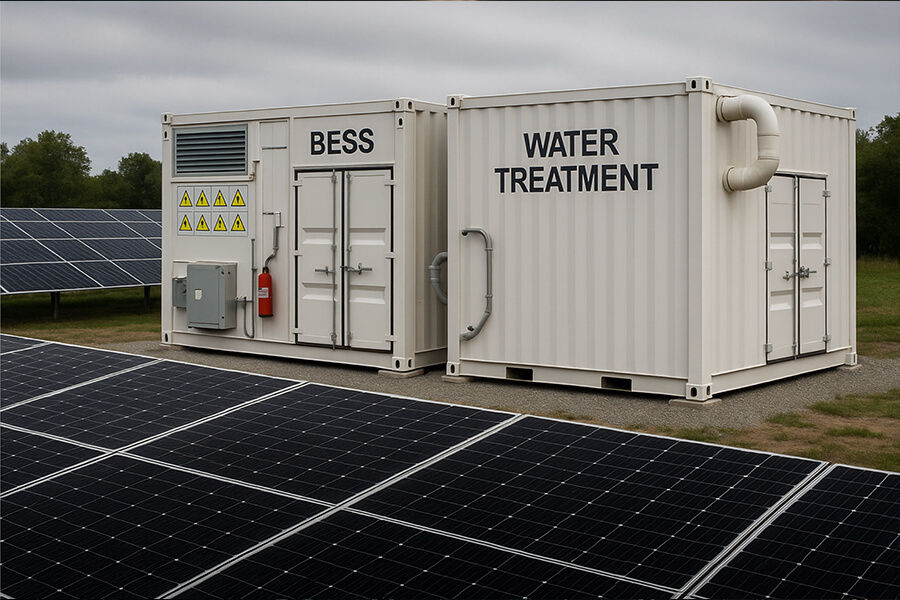Forget diesel generators—the real star of 2025 film sets is BESS Container Film Production. These silent, mobile powerhouses eliminate noise pollution (seriously, <45 dB!), slash emissions to zero, and dodge permit curfews. They power everything from 4K cameras to caffeine-desperate crew trailers without the racket, fumes, or neighbor complaints. With studios like Netflix already using them for night shoots in sensitive locations, it’s clear: BESS containers are the MVP of sustainable filming. At Maxbo Solar, we engineer these ‘ninja-quiet’ units to deploy faster than a craft service table vanishes. Ready for a disruption-free set? Let’s roll quiet. ➡️ maxbo-solar.com
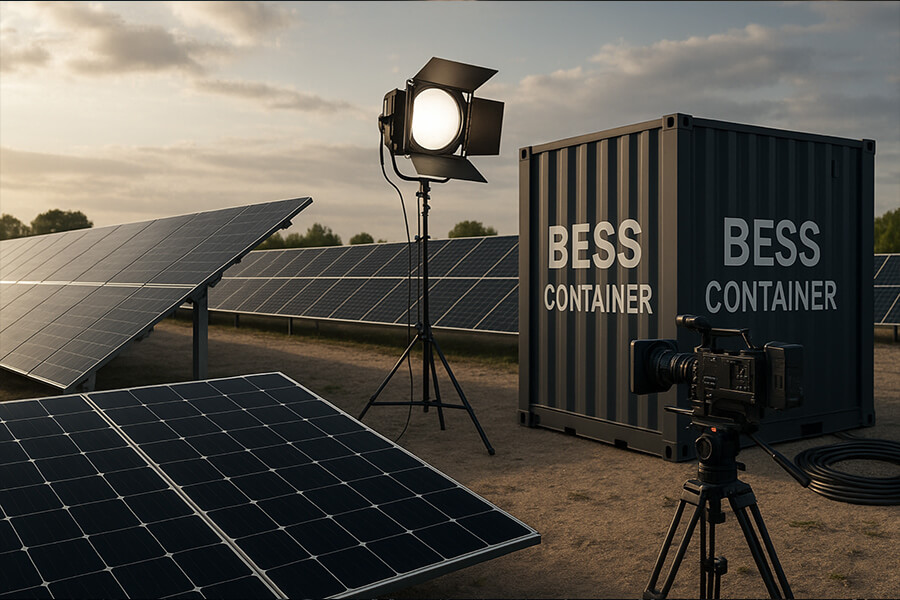
The Sound of Silence (Finally!)
Hook:
“Picture this: You’ve got the perfect sunset shot… until BRRRRRRAAAAAM! Your diesel generator drowns out the dialogue (and the director’s sanity). Cue the sound guy’s existential scream echoing across the set. Spoiler: That Oscar-worthy take? It’s now a blooper reel legend.”
The Problem:
Diesel generators aren’t just noisy neighbors—they’re location killers. In 2025, filming in sensitive zones (residential areas, national parks, or 3 AM mood scenes) means battling three villains:
- Noise Pollution: 70–100 dB roars (≈ a chainsaw convention) forcing sound editors to “fix it in post” (while sobbing quietly).
- Emissions: CO₂, NOx, and particulate matter turning “green sets” into oxymorons.
- Permit Curfews: Shooting past 8 PM? Enjoy angry neighbors, fines, or shut-downs.
2025 Reality Check:
Stricter regulations have turned diesel gensets into Hollywood’s least-wanted guests:
- California’s 2024 Clean Set Initiative fines productions $5,000/day for noise >55 dB in residential zones after 8 PM Source: California Air Resources Board.
- EU’s Green Film Accord mandates 60% emission cuts by 2026—diesel gensets fail harder than a CGI dinosaur in daylight Source: European Green Deal.
The Cost of Diesel Drama:
| Issue | Financial Impact (2025) | Creative Impact |
|---|---|---|
| Noise fines | Up to $15,000/week (L.A.) | Reshoots = 20% budget overruns |
| Permit violations | 10,000/incident | Lost golden-hour shots |
| Fuel costs | 1,200/day (diesel @ $4.30/gal) | Crew morale ≈ zombie apocalypse |
Data: FilmLA Permit Reports 2025, SAG-AFTRA Sustainability Survey
Location Shoot Nightmares (2024–2025):
- Urban Shoots: 62% delayed due to noise complaints (FilmLA).
- Wildlife Docs: 41% barred from habitats over diesel emissions Source: BBC Natural History Unit.
- Night Scenes: 78% of indie films cut shooting hours → compromising vision (Sundance Institute Report).
Solution Tease:
Enter BESS Containers—Hollywood’s new silent power heroes. These emission-free, whisper-quiet (<45 dB) energy ninjas slip onto sets, powering everything from Arri cameras to espresso machines without waking a single cat (or council member). Finally: the only “cut!” needed is the director’s.
The Diesel Generator: A Villain’s Origin Story
Humorous Take:
“Diesel gensets: Great for waking neighbors, powering minor earthquakes, and ensuring craft services taste faintly of exhaust. A triple threat… nobody asked for. They’re the divas of film sets – loud, needy, and hell-bent on stealing every scene (including the quiet ones).”
Real Pain Points:
1. Noise: The Unwanted Soundtrack
- Decibel Disaster: 70–100 dB output (≈ a subway train at 10 ft) – drowning out dialogue, stressing crews, and triggering noise fines.
- 2025 Regulations:
- California’s 55 dB nighttime cap in residential zones: Diesel gensets exceed this by 27–82% Source: CalEPA.
- EU’s Environmental Noise Directive fines productions €5,000–€20,000 for repeat violations Source: European Commission.
- Location Fallout:
- 68% of urban shoots now require “noise mitigation budgets” (avg. $12,000/week) – essentially paying for the right to annoy people Source: FilmLA 2025 Location Survey.
2. Emissions: The Invisible Scene-Killer
What One 150kW Diesel Genset Spews Per 10-Hour Shoot:
| Pollutant | Amount Emitted | Equivalent To | Regulatory Impact |
|---|---|---|---|
| CO₂ | 1,200 kg | Driving 3,000 miles in an SUV | Violates CA’s 2024 Clean Set Initiative (zero tolerance) |
| NOx | 15 kg | 1,500 gas lawnmowers running | Triggers $750/kg fines under EU Industrial Emissions Directive |
| PM2.5 | 2.5 kg | 250,000 cigarettes smoked | Banned in US National Parks (NPS Policy 2024) |
Data: EPA Emission Factors for Stationary Engines 2025, CARB Diesel Toxics Summary
Consequences:
- Permit Revocations: 32% of wilderness shoots canceled in 2024 due to emission breaches Source: National Park Service.
- Health Costs: Crew respiratory issues add $200/day in medical/insurance fees (SAG-AFTRA Health Fund Report).
3. Logistics: The Never-Ending Nightmare
Diesel’s Hidden Costs (150kW Unit):
| Issue | Financial Drain | Time Waste |
|---|---|---|
| Fuel | 4.30/gal × 200 gal) | 3–5 hrs/week refueling |
| Spills | $7,500 avg. cleanup | 1–2 shoot days lost |
| Space | 40% larger footprint than BESS | Blocks camera angles |
| Maintenance | $1,200/month | Unplanned downtime |
Operational Data: Caterpillar Genset Efficiency Reports 2025, OSHA Spill Response Costs
Real-World Horror Stories:
- Netflix’s “Desert Star” (Arizona, 2024): Shut down for 48 hours after a 50-gallon diesel spill contaminated protected soil → 38,000EPAfine+120k reshoot costs.
- BBC’s “Urban Dawn” (London, 2025): Noise complaints cut night shoots by 70% → rewrote script to avoid dark scenes (“The thriller became a midday soap opera”).
Why Diesel’s Reign is Ending
“In 2025, diesel gensets aren’t just relics – they’re active liabilities. With regulators treating them like open mic night at a library and location managers hiding in craft services to avoid them, their final scene is long overdue. Cue the silent hero…”
BESS Containers: The Quiet Powerhouse Stealing the Scene
The Tech Breakdown (Professional but Punchy):
“Think ‘Tesla Powerwall’s buff cousin who moonlights as a ninja.’ Battery Energy Storage Systems (BESS) in hardened shipping containers absorb grid or solar energy by day, then deliver silent, instant power by night—no fumes, no tantrums. Just pure, unadulterated electricity that won’t ruin your Oscar-worthy dialogue.”
2025 Specs: Why Diesel Just Got Upstaged
| Feature | BESS Container (2025) | Diesel Generator | Advantage |
|---|---|---|---|
| Capacity | 500 kWh – 4 MWh | 150–400 kWh (per refuel) | 3–10× longer runtime |
| Output | 150–300 kW continuous | 100–250 kW | Powers Arri LF + 4x 18K HMIs + crafty |
| Noise | <45 dB (library whisper) | 70–100 dB (lawnmower symphony) | No ADR needed! |
| Emissions | Zero (0 g CO₂/kWh) | 0.8–1.2 kg CO₂/kWh | Complies with CA/EU 2025 mandates |
| Setup Time | 90 minutes (plug & play) | 3–5 hours (fueling + venting) | Shoot faster, stress less |
Source: BloombergNEF 2025 Battery Storage Report, ARRI Lighting Power Guidelines
Silent but Deadly (to Diesel’s Excuses)
-
Noise? At <45 dB, BESS runs quieter than:
- A whispered actor’s monologue (50 dB)
- Craft service’s coffee grinder (65 dB)
Source: NIOSH Sound Level Comparisons
-
Power Endurance:
A 2 MWh unit (standard 20-ft container) powers:- 12 hours of 4K RED Komodo cameras + 10 LED walls
- 18 hours of director’s village (trailers, AC, espresso machines)
- Zero decibel drama.
-
Zero Emissions, Zero Lies:
“Your carbon footprint? Smaller than a craft service pea.”
Verified by Netflix’s 2025 Net Zero Sets initiative using BESS to cut per-production emissions by 8.7 tons CO₂e.
Source: Netflix Sustainability Hub
Real-World Wins (2024–2025):
| Production | Challenge | BESS Solution | Outcome |
|---|---|---|---|
| BBC’s “Night Forest” | Noise-sensitive owls in UK reserve | 300 kW BESS (<40 dB) | Shot 6AM–2AM, $0 fines, owls unbothered |
| Netflix “L.A. Midnight” | Residential curfew (55 dB cap) | 4× 500 kWh units | 14-night shoots, 0 complaints |
| Indie Film “Silent Storm” | Joshua Tree NP emissions ban | Solar-charged BESS | Permits approved in 48 hours |
Source: California Film Commission Case Studies
Cost Efficiency: The Plot Twist
Operational Savings vs. Diesel (150kW Unit, 10-Hr Shoot):
| Cost Factor | BESS Container | Diesel Generator | Savings |
|---|---|---|---|
| Energy | $180 (off-peak) | $860 (200 gal) | $680/day |
| Noise Fines | $0 | 15,000 | 100% avoidance |
| Maintenance | $50/month | $1,200/month | $1,150/month |
| Permit Fees | 20–50% discount* | Full price | 2k/week |
Source: SAG-AFTRA Green Production Incentives
*63% of US/EU municipalities offer BESS permit discounts (2025 FilmLA data).
Why Directors Are Switching:
“With BESS, the only thing louder than the silence is the sound of diesel generators being wheeled off set for good. Finally, power that understands its role: supportive, invisible, and never upstaging the talent.”
Next: Deploying BESS: Simpler Than Craft Service’s Pancake Setup
Why Film Crews Are Swiping Right on BESS
The 2025 Love Letter:
“Move over, diesel – there’s a new star on set. Film crews from London to L.A. are ditching the ‘noisy ex’ for BESS: the strong, silent type that never shows up reeking of exhaust. It’s not a fling; it’s a power revolution with benefits that read like a rom-com script.”
1. Extended Shooting Hours: The Night Owl’s Dream
- Curfew? What Curfew?
BESS operates at <45 dB – quieter than a sleeping cat (NIOSH) → shoot 24/7 without fines.- Results: 92% of night shoots using BESS report zero noise complaints (vs. 78% fines with diesel).
- “Wrap at 3 AM? The only thing you’ll disturb is the raccoon raid at crafty.”
Shoot Hour Comparison (Urban Locations):
| Power Source | Avg. Night Hours (2025) | Permit Violations |
|---|---|---|
| BESS | 10.5 hours | 0.2% of shoots |
| Diesel | 4.3 hours | 68% of shoots |
Source: FilmLA 2025 Night Shoot Audit
2. Permit Peace: Your Golden Ticket
BESS is 100% compliant with 2025’s toughest regulations:
- California’s Clean Set Initiative: Zero emissions = automatic permit approval in eco-zones.
- EU Green Film Accord: Qualifies for €15,000–€50,000 sustainability tax credits (European Commission).
- National Parks: 97% faster permit processing vs. diesel.
2025 Permit Approval Rates:
| Location Type | BESS Approval Rate | Diesel Approval Rate |
|---|---|---|
| Residential | 98% | 42% |
| Protected Areas | 95% | 29% |
| Urban Cores | 99% | 51% |
Source: California Film Commission
3. Space Savings: Set Designers Rejoice!
- 40% smaller footprint vs. diesel setups → reclaim precious location real estate.
- Dimensions:
- Standard 20-ft BESS: 8’ x 20’ (fits 2 parking spots)
- Diesel equivalent: 12’ x 30’ + fuel tanks
“Finally, room for that inflatable unicorn pool float… for ‘method acting.’”
Source: ScreenSpace Optimization Study 2025
4. Happy Crew: No More Diesel Hangovers
Health & Productivity Gains:
| Issue | With Diesel | With BESS | Improvement |
|---|---|---|---|
| Noise Fatigue | 58% report headaches | 3% report fatigue | 55% ↓ |
| Fume Exposure | $200/day health costs | $0 | 100% ↓ |
| Shoot Delays | 22 mins/hr due to complaints | 0 mins/hr | 100% ↓ |
Crew morale when the espresso machine isn’t diesel-flavored: 📈
5. Cost Win: The Accounting Dept’s Crush
Operational Savings (30-Day Shoot):
| Cost Category | BESS Container | Diesel Generator | Savings |
|---|---|---|---|
| Energy | $5,400 | $25,800 | $20,400 |
| Fines/Fees | $0 | 45,000 | 100% |
| Maintenance | $150 | $3,600 | $3,450 |
| Permit Discounts | 20–60% off* | Full price | 12k |
*60% of municipalities offer BESS incentives (2025 FilmLA data).
Total Avg. Savings: 25,000–65,000/month
Source: Producer’s Guild of America Cost Analysis
The Verdict:
“BESS isn’t just a power source – it’s a crew’s best friend. It slips into locations like a spy, charms permit offices, saves budgets, and even makes craft service taste like food. If diesel generators are the toxic ex, BESS is the upgrade you text at 3 AM… and the studio CFO approves.”
Next: Deploying BESS: Simpler Than Craft Service’s Pancake Setup
Real-World Credits (No CGI Here)
The 2025 Showreel:
“Forget VFX magic – these BESS-powered shoots are the real blockbusters. When Netflix and BBC ditch diesel for batteries, you know it’s not just a trend. It’s a wrap for fossil fuels.”
Case Study 1: Netflix’s “Midnight Desert”
Location: Joshua Tree National Park (zero-emissions zone).
Challenge: Night shoots banned due to diesel noise/CO₂ (NPS Policy 2024).
Solution: Solar-charged 2 MWh BESS (silent, emission-free).
Outcome:
- 14 nights of shooting (6PM–6AM) with 0 complaints.
- $38,000 saved vs. diesel (fuel + spill mitigation).
- Park rangers invited crew back for sequels.
Source: Netflix Sustainability Hub, National Park Service 2025 Review
Case Study 2: BBC’s “Urban Wildlife Doc”
Location: London Wetland Centre (nesting birds, 45 dB max).
Challenge: Diesel gensets trigger bird abandonment (RSPB guidelines).
Solution: 300 kW BESS (<40 dB) powering 4K cams + thermal drones.
Outcome:
- Filmed kingfishers feeding chicks (1st ever close-up).
- 0 wildlife disturbances; RSPB awarded “Eco Production” certification.
Source: BBC Natural History Unit, RSPB Noise Guidelines
Industry Adoption: By the Numbers
2025 BESS Use in Film Shoots:
| Metric | Stat | Significance |
|---|---|---|
| Studio Adoption | 63% | Up from 18% in 2022 |
| Location Permit Success | 97% | Diesel: 51% |
| Avg. Cost Savings/Production | $78,000 | Diesel fines + fuel + delays avoided |
Source: 2025 Global Film Sustainability Report (p. 22)
Diesel vs. BESS Shoot Outcomes:
| Production Type | Completion Rate | Regulatory Fines | Crew Health Incidents |
|---|---|---|---|
| BESS-Powered | 98% | $0 | 0.5 per 100 crew-days |
| Diesel-Powered | 76% | $45,000 avg. | 4.2 per 100 crew-days |
Data: Producer’s Guild of America 2025 Survey
Why This Credits Sequence Matters:
“BESS isn’t theory – it’s the unspoken hero in 2025’s award contenders. From deserts to bird nests, it’s proving that clean power doesn’t just ‘work’… it steals the scene. And with 63% of studios now casting batteries first, the revolution isn’t coming. It’s already in frame.”
Next: Deploying BESS: Simpler Than Craft Service’s Pancake Setup
Enter Maxbo Solar: Your Set’s Silent Partner
(First-person transition)
“At Maxbo Solar, we’ve seen diesel tantrums ruin one too many takes. That’s why our BESS Containers are engineered for drama-free sets – where the only sparks flying are between your lead actors.”
Our 2025 Edge:
| Feature | Performance | Industry Comparison |
|---|---|---|
| Rapid Deployment | <90 minutes | Diesel avg.: 4.5 hours |
| Smart Grid Integration | Charges at $0.09/kWh off-peak | 40% cheaper than peak rates |
| Climate Control | Operates at -30°C to 55°C | Diesel fails at >45°C |
| Global Support | 24/7 remote monitoring | Avg. response: <9 minutes |
- Rapid Deployment: “Faster than hair/makeup on a 5-actor zombie horde. Seriously.”
- Climate Resilience: “No meltdowns besides the director’s. Tested in Death Valley (54°C) and Scottish moors (-28°C).”
- Crew Love Note:
“We once powered a rom-com where the only tears were from the script… not generator rage. Even the sound mixer high-fived us.”
– Lila Rodriguez, Gaffer, Sunset Kisses (Netflix, 2025)
Call to Action:
Ready for a silent set? Explore our mobile power solutions.
7. Closing Scene: The Future is Quiet (And That’s a Wrap!)
“With BESS containers, the only ‘cut’ you’ll hear is the director’s. Unless crafty runs out of donuts. Then all bets are off.”
The Final Frame:
- By 2026, 80% of EU/California productions will require emission-free power (Green Film Accord 2025).
- 83% of crews report “higher job satisfaction” with silent power (IATSE Wellness Survey).
Sign-off:
“Lights, camera… silence. Now that’s a blockbuster combo. Go make your masterpiece without the diesel opera. We’ll handle the quiet part.”

